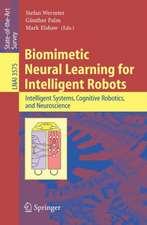Emergent Neural Computational Architectures Based on Neuroscience: Towards Neuroscience-Inspired Computing: Lecture Notes in Computer Science, cartea 2036
Editat de Stefan Wermter, Jim Austin, David Willshawen Limba Engleză Paperback – 25 iul 2001
Din seria Lecture Notes in Computer Science
- 20%
 Preț: 1061.55 lei
Preț: 1061.55 lei - 20%
 Preț: 307.71 lei
Preț: 307.71 lei - 20%
 Preț: 438.69 lei
Preț: 438.69 lei - 20%
 Preț: 579.30 lei
Preț: 579.30 lei -
 Preț: 410.88 lei
Preț: 410.88 lei - 17%
 Preț: 427.22 lei
Preț: 427.22 lei - 20%
 Preț: 596.46 lei
Preț: 596.46 lei - 15%
 Preț: 448.04 lei
Preț: 448.04 lei - 20%
 Preț: 353.50 lei
Preț: 353.50 lei -
 Preț: 389.49 lei
Preț: 389.49 lei - 20%
 Preț: 309.90 lei
Preț: 309.90 lei - 20%
 Preț: 645.28 lei
Preț: 645.28 lei - 20%
 Preț: 763.23 lei
Preț: 763.23 lei - 15%
 Preț: 580.46 lei
Preț: 580.46 lei - 20%
 Preț: 310.28 lei
Preț: 310.28 lei - 20%
 Preț: 655.02 lei
Preț: 655.02 lei - 20%
 Preț: 1183.14 lei
Preț: 1183.14 lei - 20%
 Preț: 340.32 lei
Preț: 340.32 lei -
 Preț: 449.57 lei
Preț: 449.57 lei - 20%
 Preț: 591.51 lei
Preț: 591.51 lei - 18%
 Preț: 938.83 lei
Preț: 938.83 lei - 20%
 Preț: 337.00 lei
Preț: 337.00 lei - 20%
 Preț: 649.50 lei
Preț: 649.50 lei - 20%
 Preț: 607.40 lei
Preț: 607.40 lei - 20%
 Preț: 1414.79 lei
Preț: 1414.79 lei - 20%
 Preț: 1024.44 lei
Preț: 1024.44 lei - 20%
 Preț: 583.40 lei
Preț: 583.40 lei - 20%
 Preț: 453.32 lei
Preț: 453.32 lei - 20%
 Preț: 575.49 lei
Preț: 575.49 lei - 20%
 Preț: 1075.26 lei
Preț: 1075.26 lei - 20%
 Preț: 585.88 lei
Preț: 585.88 lei - 20%
 Preț: 825.93 lei
Preț: 825.93 lei - 17%
 Preț: 360.20 lei
Preț: 360.20 lei - 20%
 Preț: 763.23 lei
Preț: 763.23 lei - 20%
 Preț: 340.32 lei
Preț: 340.32 lei - 20%
 Preț: 504.58 lei
Preț: 504.58 lei - 20%
 Preț: 369.13 lei
Preț: 369.13 lei - 20%
 Preț: 580.93 lei
Preț: 580.93 lei - 20%
 Preț: 343.62 lei
Preț: 343.62 lei - 20%
 Preț: 350.21 lei
Preț: 350.21 lei - 20%
 Preț: 583.40 lei
Preț: 583.40 lei - 20%
 Preț: 583.40 lei
Preț: 583.40 lei - 15%
 Preț: 438.59 lei
Preț: 438.59 lei - 20%
 Preț: 341.95 lei
Preț: 341.95 lei - 20%
 Preț: 238.01 lei
Preț: 238.01 lei - 20%
 Preț: 538.30 lei
Preț: 538.30 lei
Preț: 659.97 lei
Preț vechi: 824.95 lei
-20% Nou
Puncte Express: 990
Preț estimativ în valută:
126.33€ • 137.26$ • 106.18£
126.33€ • 137.26$ • 106.18£
Carte tipărită la comandă
Livrare economică 21 aprilie-05 mai
Preluare comenzi: 021 569.72.76
Specificații
ISBN-13: 9783540423638
ISBN-10: 354042363X
Pagini: 592
Ilustrații: X, 582 p.
Dimensiuni: 155 x 235 x 31 mm
Greutate: 0.82 kg
Ediția:2001
Editura: Springer Berlin, Heidelberg
Colecția Springer
Seriile Lecture Notes in Computer Science, Lecture Notes in Artificial Intelligence
Locul publicării:Berlin, Heidelberg, Germany
ISBN-10: 354042363X
Pagini: 592
Ilustrații: X, 582 p.
Dimensiuni: 155 x 235 x 31 mm
Greutate: 0.82 kg
Ediția:2001
Editura: Springer Berlin, Heidelberg
Colecția Springer
Seriile Lecture Notes in Computer Science, Lecture Notes in Artificial Intelligence
Locul publicării:Berlin, Heidelberg, Germany
Public țintă
ResearchCuprins
Towards Novel Neuroscience-Inspired Computing.- Towards Novel Neuroscience-Inspired Computing.- Modular Organisation and Robustness.- Images of the Mind: Brain Images and Neural Networks.- Stimulus-Independent Data Analysis for fMRI.- Emergence of Modularity within One Sheet of Neurons: A Model Comparison.- Computational Investigation of Hemispheric Specialization and Interactions.- Explorations of the Interaction between Split Processing and Stimulus Types.- Modularity and Specialized Learning: Mapping between Agent Architectures and Brain Organization.- Biased Competition Mechanisms for Visual Attention in a Multimodular Neurodynamical System.- Recurrent Long-Range Interactions in Early Vision.- Neural Mechanisms for Representing Surface and Contour Features.- Representations of Neuronal Models Using Minimal and Bilinear Realisations.- Collaborative Cell Assemblies: Building Blocks of Cortical Computation.- On the Influence of Threshold Variability in a Mean-Field Model of the Visual Cortex.- Towards Computational Neural Systems through Developmental Evolution.- The Complexity of the Brain: Structural, Functional, and Dynamic Modules.- Timing and Synchronisation.- Synchronisation, Binding, and the Role of Correlated Firing in Fast Information Transmission.- Segmenting State into Entities and Its Implication for Learning.- Temporal Structure of Neural Activity and Modelling of Information Processing in the Brain.- Role of the Cerebellum in Time-Critical Goal-Oriented Behaviour: Anatomical Basis and Control Principle.- Locust Olfaction.- Temporal Coding in Neuronal Populations in the Presence of Axonal and Dendritic Conduction Time Delays.- The Role of Brain Chaos.- Neural Network Classification of Word Evoked Neuromagnetic Brain Activity.- Simulation Studies of the Speed of Recurrent Processing.- Learning and Memory Storage.- The Dynamics of Learning and Memory: Lessons from Neuroscience.- Biological Grounding of Recruitment Learning and Vicinal Algorithms in Long-Term Potentiation.- Plasticity and Nativism: Towards a Resolution of an Apparent Paradox.- Cell Assemblies as an Intermediate Level Model of Cognition.- Modelling Higher Cognitive Functions with Hebbian Cell Assemblies.- Spiking Associative Memory and Scene Segmentation by Synchronization of Cortical Activity.- A Familiarity Discrimination Algorithm Inspired by Computations of the Perirhinal Cortex.- Linguistic Computation with State Space Trajectories.- Robust Stimulus Encoding in Olfactory Processing: Hyperacuity and Efficient Signal Transmission.- Finite-State Computation in Analog Neural Networks: Steps towards Biologically Plausible Models?.- An Investigation into the Role of Cortical Synaptic Depression in Auditory Processing.- The Role of Memory, Anxiety, and Hebbian Learning in Hippocampal Function: Novel Explorations in Computational Neuroscience and Robotics.- Using a Time-Delay Actor-Critic Neural Architecture with Dopamine-Like Reinforcement Signal for Learning in Autonomous Robots.- Connectionist Propositional Logic A Simple Correlation Matrix Memory Based Reasoning System.- Analysis and Synthesis of Agents That Learn from Distributed Dynamic Data Sources.- Connectionist Neuroimaging.
Caracteristici
Includes supplementary material: sn.pub/extras























